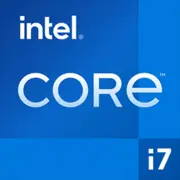Intel Core i7-9750H

Intel Core i7-9750H 2025年: 「ベテラン」を手に入れる価値はあるか?
アーキテクチャ、パフォーマンス、使用シナリオの分析
アーキテクチャとプロセス技術: Coffee Lake 14nm
2019年に発売されたIntel Core i7-9750Hは、Coffee Lake-H世代に属します。2025年には14nmプロセス技術はAppleの5nmチップやAMDの4nmソリューションに比べて古く見えますが、このプロセスは当時、モバイルワークステーションやゲーミングノートパソコンの標準でした。
- コアとスレッド: 6コア、Hyper-Threadingによって12スレッド。ベースクロックは2.6 GHz、Turbo Boost時の最大は4.5 GHzです。
- キャッシュ: 12 MBのL3キャッシュは、レンダリングやビデオエンコーディングのようなマルチスレッドタスクには十分です。
- 統合グラフィックス: Intel UHD Graphics 630で、基本クロックは350 MHz、最大は1.15 GHz。ゲームやプロフェッショナルな編集には、専用グラフィックカードとの組み合わせが必要です。
Coffee Lakeアーキテクチャは、パフォーマンスとエネルギー効率のバランスを最適化していますが、2025年にはPCIe 4.0のサポートが欠けており、DDR4-2666 MHzの制限が主な欠点です。
エネルギー消費とTDP: 45W — 二面性を持つ一つの柱
TDPが45Wであるということは、高いパフォーマンスを求められますが、効率的な冷却システムが必要になります。コンパクトなウルトラブックではi7-9750Hは滅多に見かけず、むしろ大型のゲーミングノートやモバイルワークステーションでよく見られます。
- 熱放散: 負荷がかかるとチップは簡単に90〜95°Cに達します(冷却が不十分な場合)。これによりスロットリング(周波数の低下)が発生します。
- 電力供給: Turbo Boost時にはエネルギー消費が短時間70〜80Wに達する可能性があり、高出力の電源ユニットが必要です。
パフォーマンス: 2025年にどのように対応するか?
Geekbench 6の評価(1349 / 4935)は、i7-9750Hが基本的なシナリオで依然として競争力があることを示しています。
- オフィスタスク: 文書作成、ブラウザ(20以上のタブ)、ビデオ会議 — プロセッサは問題なく動作します。
- マルチメディア: Lightroomでの写真編集やPremiere Proでの1080pビデオ編集は許容範囲ですが、4Kレンダリングや効果をいじるには時間がかかるかもしれません。
- ゲーム: NVIDIA RTX 3060やAMD RX 6600MのようなGPUと組み合わせることで、フルHDで60FPS以上を達成します(例: Cyberpunk 2077を中設定で)。ただし、CPU依存のプロジェクト(例: Microsoft Flight Simulator)では、古いアーキテクチャのためにパフォーマンスが低下することがあります。
- Turbo Boost: 理想的な条件(良好な冷却)では、4.5 GHzが10〜15秒間持続し、その後3.8〜4.0 GHzに落ちます。
使用シナリオ: 2025年に誰に向いているか?
- 学生とオフィスワーカー: 学業、テキスト作業、Zoomには過剰ですが、パフォーマンスの余裕があります。
- 予算のあるゲーマー: 中程度のパフォーマンスの専用GPU(GTX 1660 Ti、RTX 3050)と組み合わせることで、フルHDでゲームを楽しめます。
- フリーランサー: 中規模プロジェクトに取り組む編集者やデザイナー。
推奨されないのは、CPUに高負荷なタスク:3Dレンダリング、4Kストリーミング、AI計算です。
バッテリー寿命: ノートパソコンはどれくらい持つか?
TDPが45Wであるため、驚くような結果は期待できません。アイドル状態(ウェブ閲覧、ビデオ視聴)で、i7-9750H搭載の60Whバッテリーのノートパソコンは5〜6時間動作します。負荷がかかると1.5〜2時間になります。
Intel省電力技術:
- SpeedStep: 低負荷時に動的にクロックを下げます。
- C-States: 未使用のコアをオフにします。
しかし、それでも高い基本エネルギー消費を免れることはできません。比較として、Apple M2搭載のノートパソコンは同様のバッテリーで12〜15時間動作します。
競合との比較
- AMD Ryzen 5 5600H (Zen 3, 7nm): マルチスレッドパフォーマンスが向上し(Cinebench R23で+15%)、熱放散が少ないです。Ryzen 5 5600H搭載のノートパソコンの平均価格は700〜900ドルです。
- Apple M1: エネルギー効率は3〜4倍優れていますが、Windowsアプリケーションとの互換性は制限されています。
- Intel Core i5-12450H (Alder Lake): シングルスレッドタスクで25%速く、DDR5をサポートします。
2025年には、i7-9750Hは主に中古市場またはバジェットモデル(500〜700ドル)での選択肢に適しています。
長所と短所
強み:
- パフォーマンスレベルに対して手頃な価格。
- 多くのプロフェッショナルソフトウェア(Adobe、AutoCAD)に対応。
- Windows 10/11及びLinuxとの互換性。
弱み:
- 高いエネルギー消費。
- 古いプロセス技術。
- AIアクセラレーションのハードウェアサポートがない(Ryzen 7040やIntel Meteor Lakeのように)。
ノートパソコン選びの推奨
- ゲーミングモデル: ASUS TUF Gaming、Acer Nitro 5。少なくともRTX 3050以上の専用グラフィックスと16GB以上のRAMを持っていることを確認してください。
- ワークステーション: Dell Precision 3540。良好な色再現性を持つディスプレイ(100% sRGB)に注目。
- バジェットユニバーサル: HP Pavilion 15。HDDのみのバージョンは避けるべきで、SSDは必須です。
重要! 冷却システムは最低でも2つのファンと熱伝導管を備えている必要があります。
最終結論
2025年のIntel Core i7-9750Hは、中程度のタスクに手頃なノートパソコンを必要とする人々の選択肢です。次のような人々に適しています:
- 予算の限られたゲーマー。
- 重いプロジェクトに取り組まないフリーランサー。
- 最新技術に対して過剰な支出を避けようとしているユーザー。
主要な利点: 現代の類似品に比べて200〜300ドルの節約、実績のある信頼性。しかし、3〜4年ノートパソコンを使用する予定があるなら、Ryzen 5 7600HやCore i5-13450H搭載モデルを検討した方がいいかもしれません。
基本
CPUの仕様
メモリ仕様
GPUの仕様
その他
ベンチマーク
他のCPUとの比較
ソーシャルメディアで共有する
または当サイトへのリンクを追加
<a href="https://cputronic.com/ja/cpu/intel-core-i7-9750h" target="_blank">Intel Core i7-9750H</a>